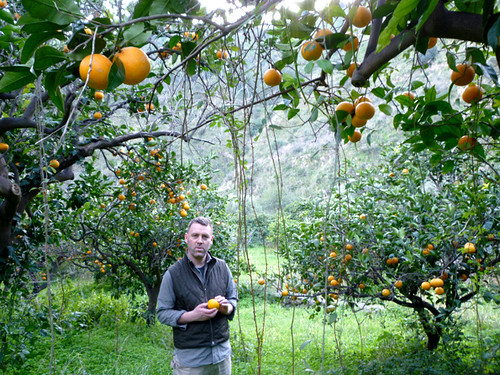Orange Tree Biography
Orange trees are beautiful, and for this reason, they are often featured in advertising as the fauna of exotic, tropical locales. What many people don't know, however, is that orange trees can be grown in your own backyard, provided you have a somewhat moderate climate and are prepared to take care of them. Read this article to find out all about the orange tree, and how to care for your own.
The orange tree was first found in Southern China and North India. Because Europeans in the 1500's valued the fruit for its medicinal qualities, it was imported by Portuguese traders into around the sixteenth century. By the seventeenth century, small greenhouses were being built in Europe to cultivate orange trees, which by then were known for their sweet taste. The orange tree reached America in the nineteenth century, introduced to Florida by the French. Today, California, Arizona and Florida are the chief orange-growing states in the Unites States.
The orange trees is cultivated for its aesthetic qualities as well as its tasty fruit. It can grow up to fifty feet if given the proper care. It usually has very thin branches, which, when they are young, tend to have tiny wing leaves on their sides. Orange leaves generally tend to be long, slender and green. Before oranges bloom on the tree, it opens white flowers in clusters of four to six, with slight, sweet smells. When oranges first appear, they are generally yellow until they turn orange. Oranges can be seedless or with seeds, orange, yellow or red.
Orange trees typically grow in subtropical temperatures. While they are growing, you must make sure that temperatures stay around 50-100 degrees. Seedling orange trees may be able to withstand dips into cold temperatures, but older trees will die. It would be wise to consider placing protection around young trees as well, and perhaps a greenhouse. Orange trees should not be pruned, as this impedes their natural development.
You must make sure the tree is in a sunny area, in soil that does not retain water. Do not plant trees in alkaline soil, as they will not be able to survive. Mulch is always an asset, as it helps water to move through the soil and provides nutrients for the tree. If your area does not receive much rain, water the tree at least once every week and a half. If temperatures drop suddenly, cover the bottom of the trees in plastic, and if it becomes extremely cold, around 30 degrees Farenheit, consider moving the tree inside. You will know when to harvest by the size and taste of the oranges. Do not harvest oranges until they re completely orange, and all green has left them.
If you plan to fertilize your tree, there are several different routes you can take. You should only fertilize the tree 4-5 times during its growth period. When figuring out the dose of fertilizer to give a tree, consider the nitrogen content on the label of the fertilizer you plan to use. Since a tree generally needs 1.5 lbs. Of nitrogen once a year, split your doses up accordingly. If you use fertilizer in the form of pellets, tablets or powder, make sure that these release nutrients slowly enough to ensure steady growth for the tree.
Orange trees are beautiful, and for this reason, they are often featured in advertising as the fauna of exotic, tropical locales. What many people don't know, however, is that orange trees can be grown in your own backyard, provided you have a somewhat moderate climate and are prepared to take care of them. Read this article to find out all about the orange tree, and how to care for your own.
The orange tree was first found in Southern China and North India. Because Europeans in the 1500's valued the fruit for its medicinal qualities, it was imported by Portuguese traders into around the sixteenth century. By the seventeenth century, small greenhouses were being built in Europe to cultivate orange trees, which by then were known for their sweet taste. The orange tree reached America in the nineteenth century, introduced to Florida by the French. Today, California, Arizona and Florida are the chief orange-growing states in the Unites States.
The orange trees is cultivated for its aesthetic qualities as well as its tasty fruit. It can grow up to fifty feet if given the proper care. It usually has very thin branches, which, when they are young, tend to have tiny wing leaves on their sides. Orange leaves generally tend to be long, slender and green. Before oranges bloom on the tree, it opens white flowers in clusters of four to six, with slight, sweet smells. When oranges first appear, they are generally yellow until they turn orange. Oranges can be seedless or with seeds, orange, yellow or red.
Orange trees typically grow in subtropical temperatures. While they are growing, you must make sure that temperatures stay around 50-100 degrees. Seedling orange trees may be able to withstand dips into cold temperatures, but older trees will die. It would be wise to consider placing protection around young trees as well, and perhaps a greenhouse. Orange trees should not be pruned, as this impedes their natural development.
You must make sure the tree is in a sunny area, in soil that does not retain water. Do not plant trees in alkaline soil, as they will not be able to survive. Mulch is always an asset, as it helps water to move through the soil and provides nutrients for the tree. If your area does not receive much rain, water the tree at least once every week and a half. If temperatures drop suddenly, cover the bottom of the trees in plastic, and if it becomes extremely cold, around 30 degrees Farenheit, consider moving the tree inside. You will know when to harvest by the size and taste of the oranges. Do not harvest oranges until they re completely orange, and all green has left them.
If you plan to fertilize your tree, there are several different routes you can take. You should only fertilize the tree 4-5 times during its growth period. When figuring out the dose of fertilizer to give a tree, consider the nitrogen content on the label of the fertilizer you plan to use. Since a tree generally needs 1.5 lbs. Of nitrogen once a year, split your doses up accordingly. If you use fertilizer in the form of pellets, tablets or powder, make sure that these release nutrients slowly enough to ensure steady growth for the tree.
Orange Tree
Orange Tree
Orange Tree
Orange Tree
Orange Tree
Orange Tree
Orange Tree
Orange Tree Advice
Growing Orange Trees From Pips








No comments:
Post a Comment